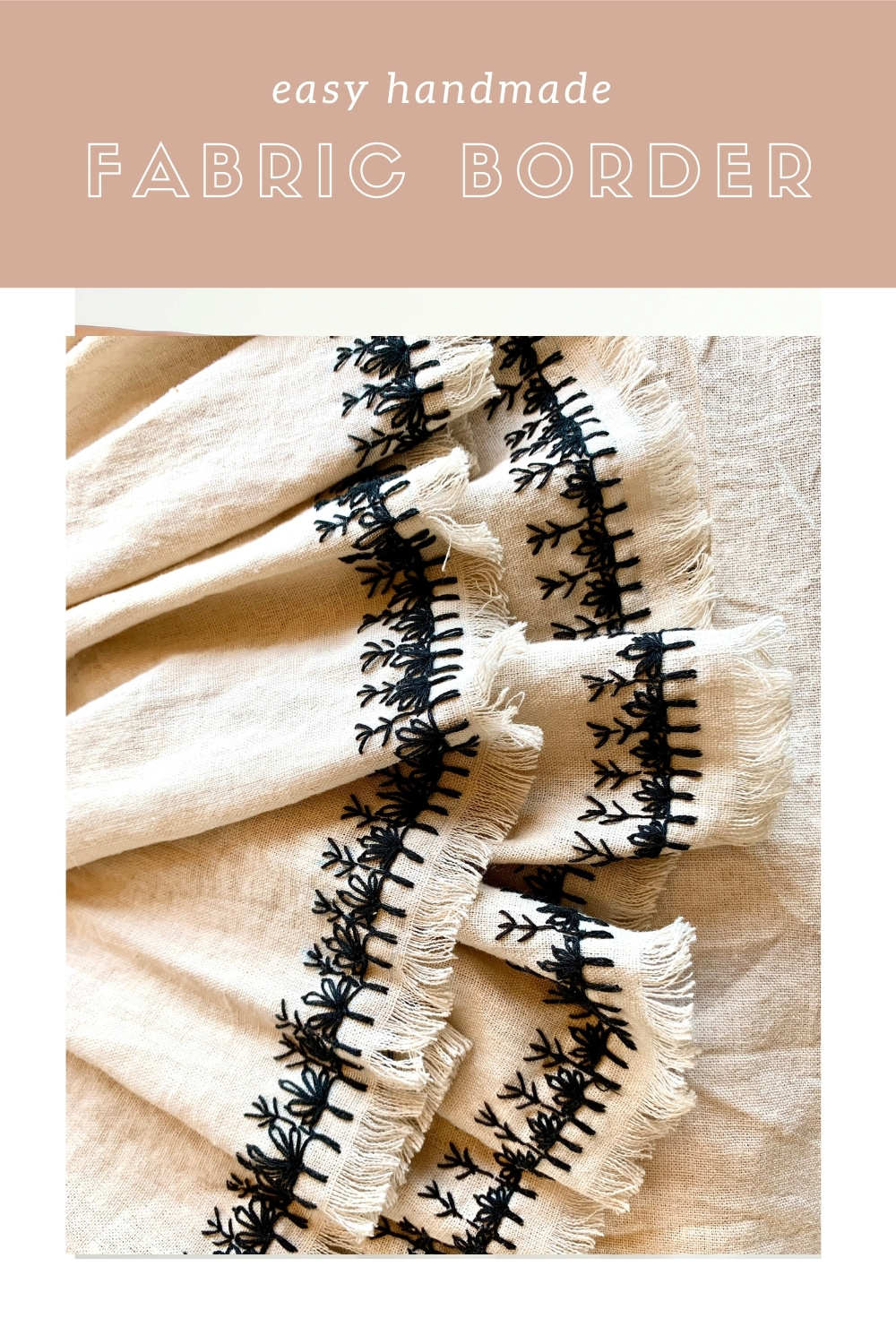
I find myself weathering the pandemic in the middle of Chile. Never in my life would I have thought that I'd be here, but the world has changed so much that it's impossible to know where we will be in a few years from now. One thing for sure is that we need to stop and consider our priorities. For some it will become an even faster and more technologically advanced world, for others, it will mean going back to the small town close to the land, and for others, some sort of combination of the two. I guess we as a family have chosen the third one, and in doing so we've seen that the learning curve is indeed steep and we find ourselves working from the very early hours to the small hours of the night with some relaxed times in between.
Embroidery is my relaxing time, a way to slow down and recharge. I love listening to one of my favorite books: A World Made By Hand by James Howard Kunstler. I encourage you to read it or listen to it. In the scenario painted by the author, you and I will be the tailors a very important job when trade and commerce all but disappear.
There is no chili in Chile by the way. I found that the spiciest thing here is a thing called Merken used in red meat before putting it in the barbecue. The food in Chile is in fact mild-tasting almost as the Castille region in Spain.
Where in the world is Chile?
Chile is located at the very end of South America flanked by the Andes mountains chain and Argentina to the east and the Pacific Ocean to the west, Peru, and Bolivia to the north.
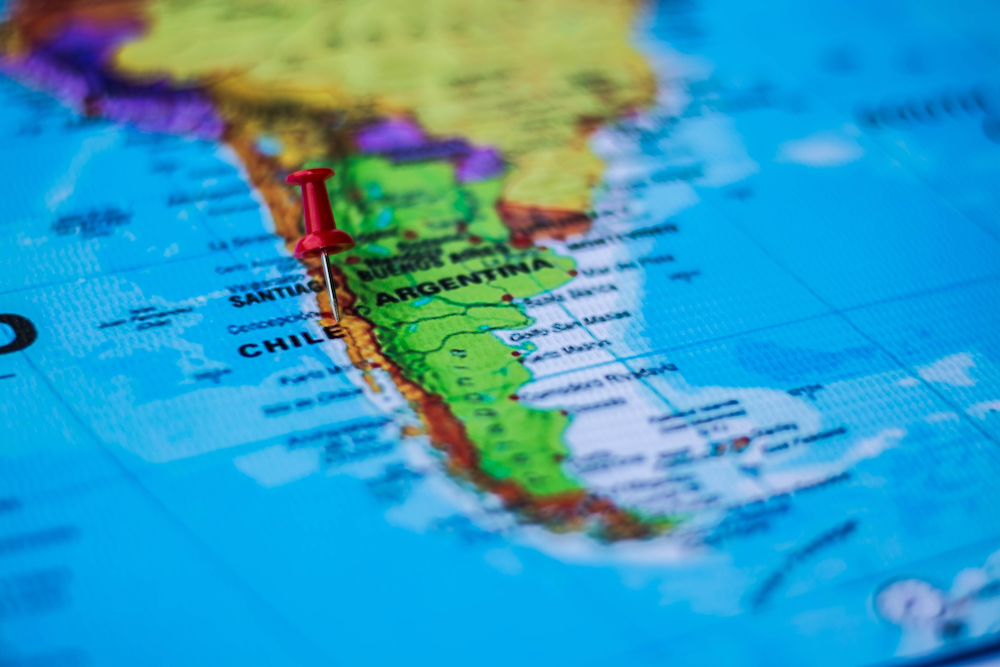

Despite being such a long country it feels like an island almost because is separated by the majestic Andes Mountains from the rest of the South American Continent.




Many people know Chile as a mining powerhouse, being the world's largest producer of important metals like copper and lithium –but what most people don't know is that Chile produces around 30% of all the fresh fruits, vegetables, and salmon sold in the world export markets today.
So yes, being a farmer is quite a popular lifestyle. You can say I am a farmer's wife and mother.
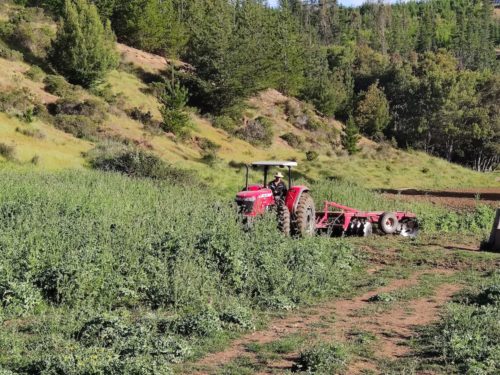

This year, I will go on the tractor I promise and of course, will be sharing my outfit, but for now, I am either a spectator or part of the cleaning and cooking crew and in between jobs I embroider or sew by hand so I thought I share with you an easy fabric border to use later.
Instructions For An Easy Handmade Fabric Border
An easy handmade fabric border is done by mixing a group of embroidery stitches to create a long-running pattern. One stitch will serve as a base for the others, one that will guide the eye upwards and one that will crown the design. The possibilities are endless and encourage you to find a design that appeals to you. Mine comes from a combination of a table cloth on an Indian painting that is more than 200 years and a weed. I am not sure the name of the weed, perhaps someone who knows can post in the comments, but it is everywhere, and it grows a very large spiky flower.
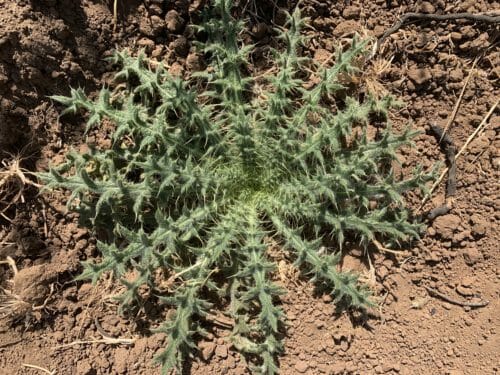

Materials I used to make this border
- DCM Black Thread #310
- Embroidery needle #10
- Thimble
- Scissors
- Ruler
- Wax
I'm embroidering on a Southern Classic Linen Blend I got from Fabric.com, but any fabric that contrasts with your thread will do.
Step One: Mark The Fabric
Start by drawing a line 5/8″ from the edge of your fabric.
Draw another line on top at 3/8″ then draw two lines more also at 3/8″.
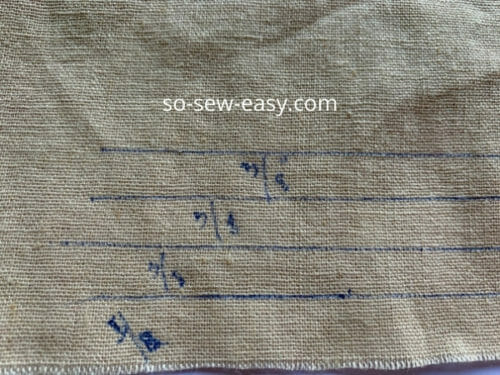

Step Two: The Upside Down Double Blanket Stitch
This is one of the seventeen variations of the blanket stitch. I'm using it upside down so it resembles a stem.
Using four-thread from in your needle, knot the end and stitch your needle on the second line from the back at 5/8″ from the edge if you are going to use your fabric for a skirt, blouse, or dress.
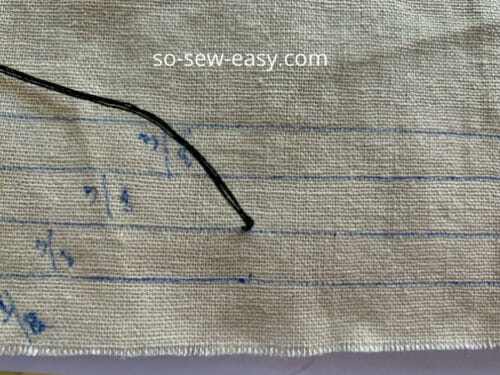

Pull the thread out and stick the needle on the line below taking the needle out next to where you started the stitch.
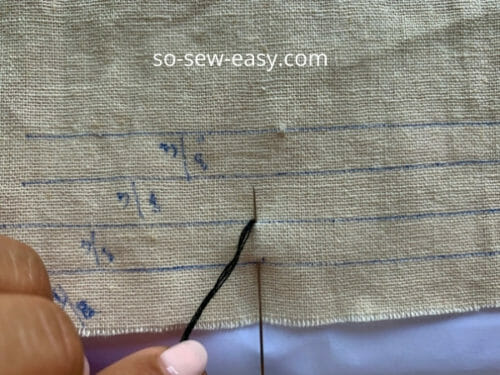

Pull the thread to the right and stick the needle on the first line at 3/8″ from the first blanket stitch. Repeat the step to make another stitch next to the first one.


take the needle out on the second line make sure the thread is under the needle.
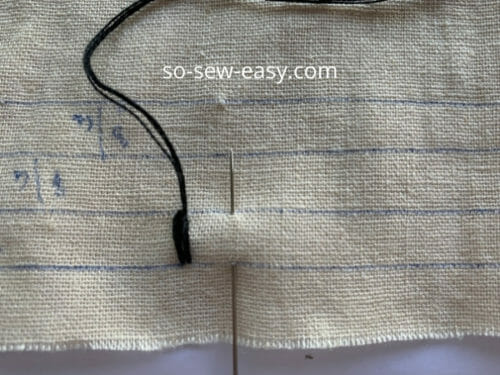

Repeat the stitch making a double blanket stitch every 3/8″.
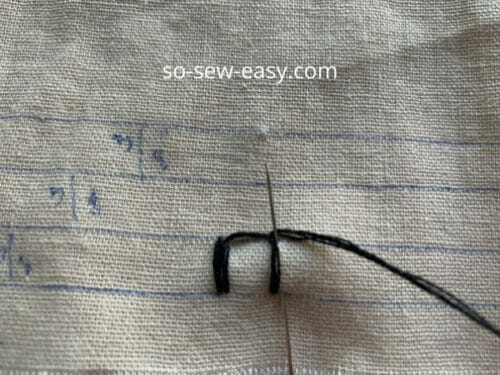

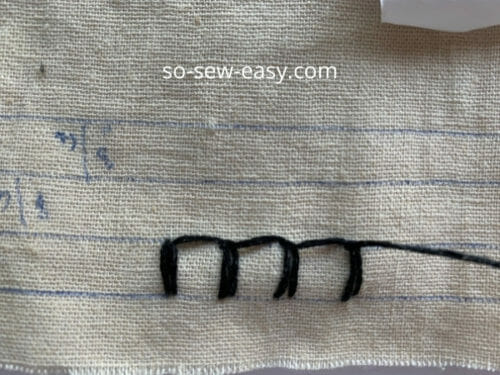

Once you have done the whole fabric edge, you can pull the edge thread to make a fringe or wait till later when you have a plan what to do with your fabric border.
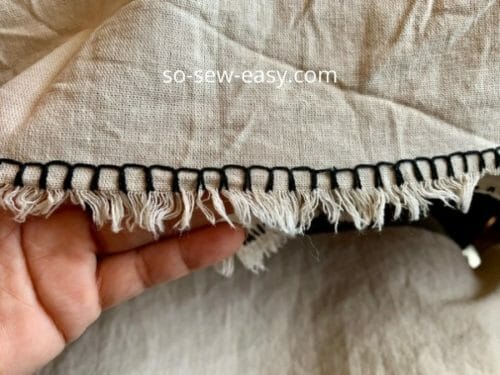

Step Three: Detach chain stitch
This is a common stitch used to make daisies and stitches to fill a space.
Draw five lines to create a bush, each line will make a branch using the detached chain stitch.
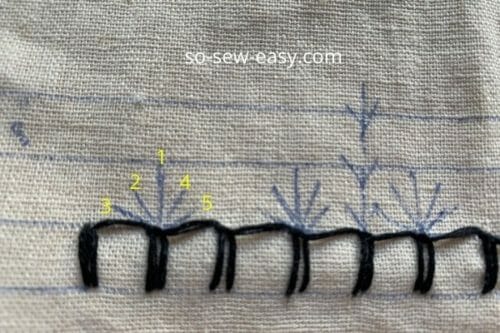

Starting at the centre follow the numbers above. Insert your needle from the back of the fabric, taking it out in the middle of the double blanket stitch, move the thread to the left.
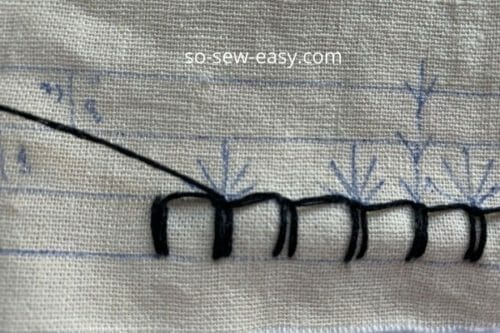

Keep the needle straight and take the needle out and pull the thread keeping the thread under the needle.
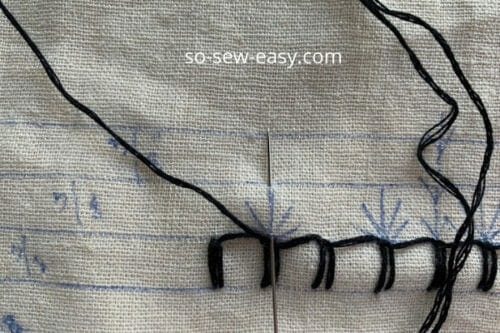

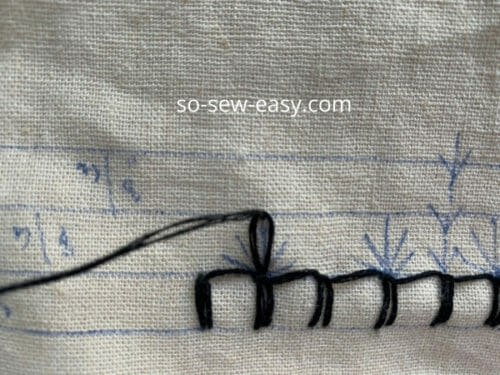

Insert the needle once again on the tip of the detached chain to make a tip about 1/8″ in length.
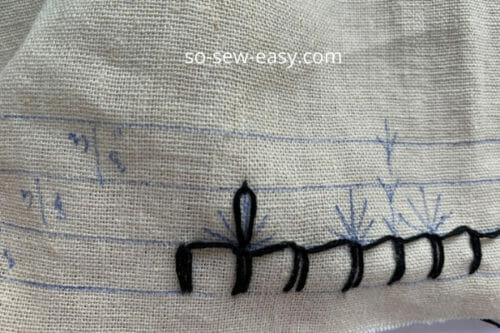

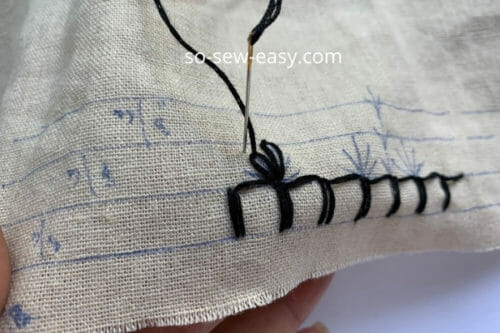

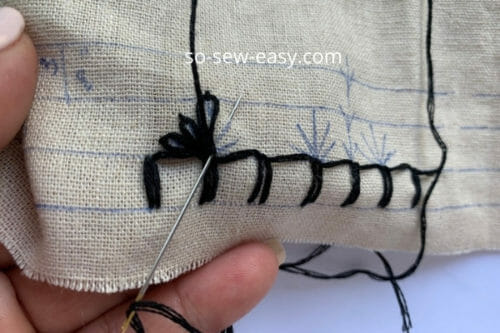

I have made the bush first because I find working like this is faster, at least for me. I do like hand stitching but there are times when you need to make things more productive.
Step Four: Combining The Fern Stitch and The Straight Stitch
The fern stitch is a lovely stitch that makes a plant rather easily and speedily. We will be using it in the flat one dimensional way and the straight stitch is to make the fern taller.
Start with one fern stitch about 3/16″ tall then one straight stitch, one fern stitch, one straight stitch and finally one last fern stitch.
Stab the needle from the back of the fabric about 3/16″ from the second line.
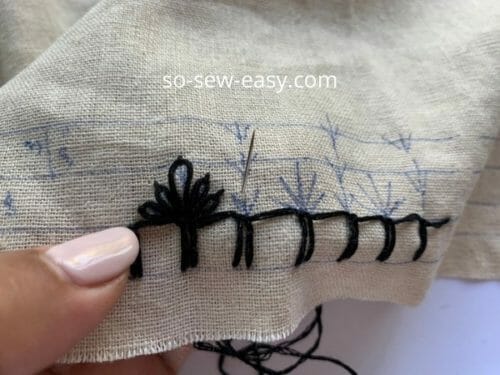

Stick the needle in the centre of the double blanket and pull it out to the left of the first stitch. Pull the thread and stab the needle back in between the double blanket stitch pull the needle to the right of the beginning of the fern stitch.
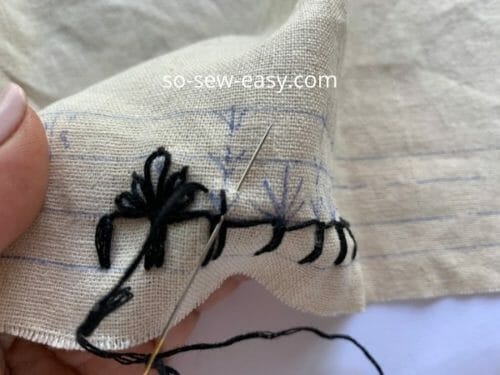

Bring the needle to the centre once again pulling it out at the top of the fern stitch.
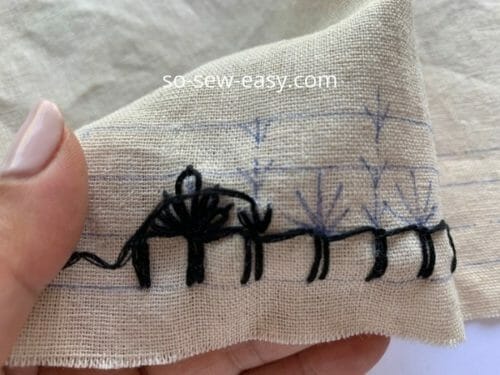

Make a straight stitch about 1/8″ in length.
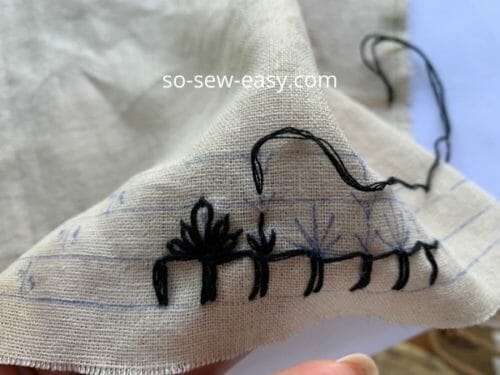

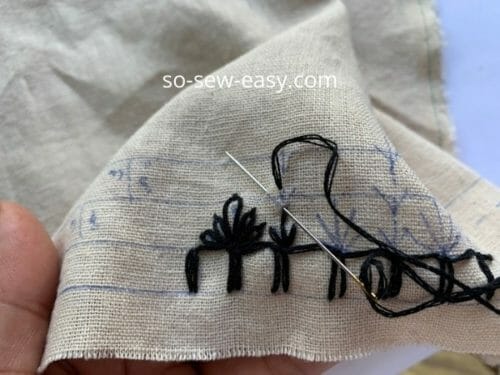

Make another fern stitch and add another straight stitch.
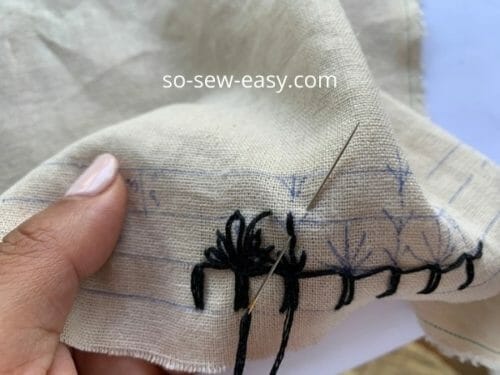

Make another straight stitch,
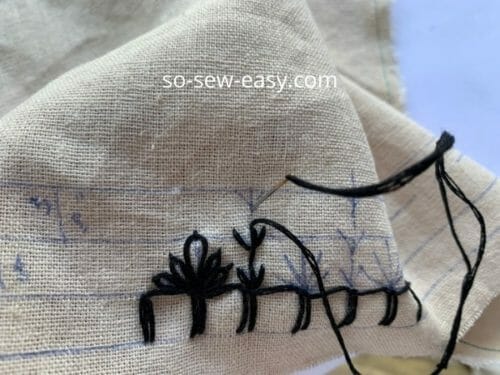

and one final fern stitch.
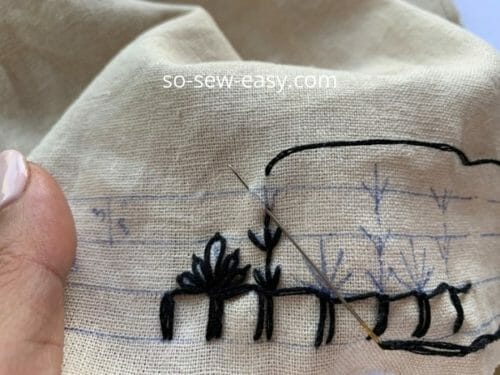

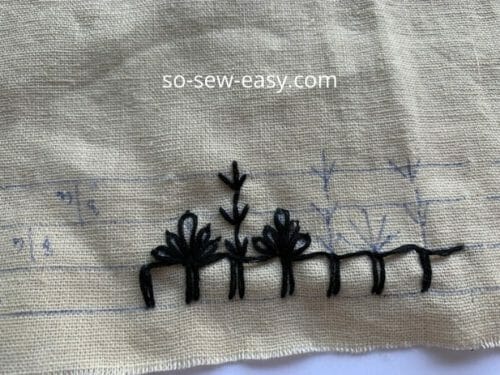

Repeat this pattern until you have filled the whole border of your fabric.
Disclaimer: I have shared above the stitches to make an easy handmade fabric border, however, because I was making this border not intended for a blog post, I made something slightly different to my fabric. I embroidered all the bushes then all the ferns. I found this way I was going faster. I guess this is called muscle memory.
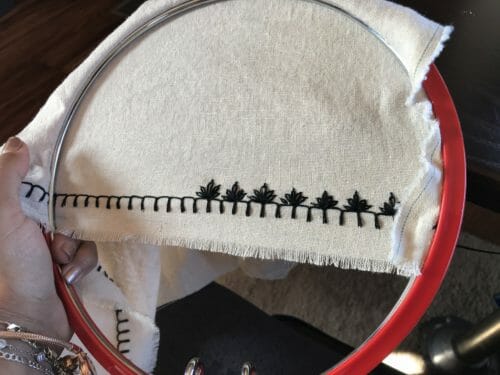

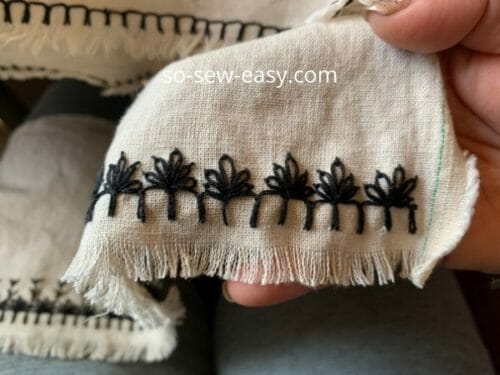

You will have noticed too that in my final project the ferns have only two stitches rather than three because I found that the bushes were to close together to have one in between.
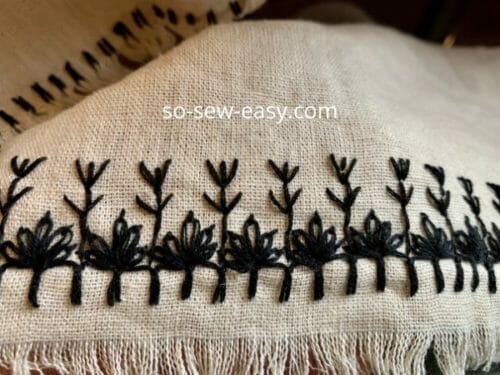

Either way, you choose. The important thing is that you are happy making this border and that you enjoy slow sewing like I do.
Before you ask what I'm going to be doing with this border, we're going to be making a lovely linen dress or table cloth. Vote in the comments sections below, table cloth or linen dress to be used with this border.
I hope you find this tutorial useful and that it helps you get inspired to do some slow stitching for a change.








It’s a beautiful border! I’m wondering what you use the wax for, though?
Thank-you for this post! I love the embroidery, how very fun Chile, too cool, I hear it’s beautiful there and the people wonderful!
Yes, Indeed it is a beautiful place…
That is a musk thistle. In most places, it is an invasive weed and you can be fined for not removing it. I had a constant battle with it at our Kansas farm. Clip the seed heads and bag them up. Then use a hoe to break the taproot. I usually found them when small and pulled them up. One spring I ended up on the edge of the neighbor’s wheat field with a hoe and took out a dozen of them to prevent the spread onto my pasture.
Thanks for the tip, they are everywhere and the cows nor the hares will not eat them.
Exactly what my experience is also.
Love the exercise pants pattern! Thanks! Your mystery plant in the picture is a thistle. What color is the flower? Yellow? Purple? That will help ID it. But all thistles are invasive. At the stage in your photo, it can be scraped out with a hoe. They do produce a long tap root, so it may resprout a couple times. Just keep scraping them with the hoe. Just as a aside, milk thistle (purple flower) was used in the old days to make cheese.
Hi Cathy, it an impressive purple flower that attracts the biggest bumblebees I have seen on the planet. I guess I will have to learn to make cheese now 🙂
Oh a dress, certainly. I too have just started small embroidery projects. I am working at a vaccine clinic during the day and in the evening I just want to do something creative. Found some really cute little designs on internet to stitch. I am thinking I might do on tee shirts.
yes, embroidery on t-shirts gives them a chic and feminine touch.
This is beautiful work, and it gives me ideas for trimming a nightgown that I want to make! I vote for using it to trim a linen dress. I’ve just recently gotten into sewing with linen, and I would love a pattern for a simple dress!
I an on it, I just hope I have enough linen for the style I am thinking of.
I’ve been to do embellishments on some new sewing projects. This is inspiring me, thank you!
Your weed is a Thistle. Here in Texas, some consider them wildflowers and some consider them weeds. The flower is the national symbol of Scotland.
Thank you! National flower of Scotland? Great trivia question. I find the flower fascinating, even when it is dry!
Such a lovely design and so easy to accomplish. Thank you for sharing and for explaining the differences between the blog post and the actual project.
My Pleasure!
Last year, I learned about Chicken Scratch Embroidery, also called Depression Lace because women used to embellish their simple gingham frocks with it during the Depression. And decided I had to make some doll dresses with it for our shoebox gifts. Here’s the pin link to the two I did: https://pin.it/ep9Ca7c.
For this year, I have on my want-to-do list some of the gorgeous Latin American style embroidery.
So beautiful! I’d love to see it on a linen dress pattern, and would be keen to sew one too.
Hi Megan, Yes, I think this is where I am leaning towards, stay tuned.
Hi Jenn, oh so lovely embroidery, so delicate. Yes, I think you will find Latin American embroidery a combination of the whole world in one design. More to come…, keep sharing your work, please.
Lovely. I look forward to trying this! I live in Ecuador and they don’t do “spicy” either but I saw “merken” at the mercado the other day and wondered what it was so thank you for clarifying.
Use it for a dress or top hem. I’ve also rediscovered hand embroidery. It’s so much fun. Beautiful pattern. Love the idea!!
I love the design. I recently took up hand embroidery and have been teaching myself the stitches via the Internet. Slow sewing is very relaxing and enjoyable. My sewing machine was in for some minor repairs and I needed something to fill the time, so hand embroidery became my new pastime. It’s like painting with thread. I have been working on tea towels as a beginner and I’m thinking of trying pillow cases next. Your border design would work well around the edge of a pillow case. Thank you for the excellent instructions.
The design is beautiful and I love the contrast of the black on the linen fabric. The tablecloth would be pretty. But I vote for the dress. I think that would be stunning!
Thank you for reminding me that hand embroidery is a relaxing pastime and can have a part to play in today’s designs. It sounds like you are deep in the country, tractors and all. By chance are you beyond the power grid? Ever considered a treadle sewing machine? If an antique isn’t your thing, Janome and probably others make contemporary treadle-powered models.
Hello, I vote for a table cloth, only because of the black thread. I would want to see lovely bright colors for a dress, but the pattern would be great for either one.
your spiky plant is a thistle, latin name (Genus) Cirsium. Not sure which species seeing that you’re in Chile, but it’s very common for these species to invade disturbed soil in pasture areas or cultivated lands. I’m a trained botanist, but love to spend my time sewing when I’m not outside. I am enjoying your tips/tricks for sewing!
I am torn! A tablecloth would be pretty but how hard will it be for food to come out of the linen and/or yarn. A skirt would be beautiful but I can see me getting a heel or something hung up in it and me falling down! I might have to go for a shirt!
Also, I found your weed. In USA we call it a Thistle. foragefax.tamu.edu.
You seem to live an exotic life going all kinds if places. Is this all due to your sewing blog?
JKAW
Jean, partly, I am convinced it has to do with a wish I made when I was 9 years old, I said I would travel the world, 43 countries, 4 continents latter I find that indeed my sewing machine, ruler, needle and thread has open the door to so many opportunities. I married a person who is equally curious and loves a challenge. Moving and starting a project is so difficult but it has taught me to care about the things that really matter family, health and friends. I love what I do, and even I was not sharing it with you I would still be doing it. Kind Regards,
I used to do a lot of hand embroidery. My aunt got me started embroidering when I was 7 or 8 years old. I made many tea towels look pretty with embroidered motifs on them 🙂 I have a runner to work on with various shades of green — the motif is a type of ivy leaf that runs around the whole runner. I bought it years ago and “lost” it in my craft containers until I found it recently and am thoroughly enjoying working on it once again. I really like the pattern you have shared. I am going to put this in a “safe” place so I can find it when I finish my current project. I love “slow” sewing — it is very relaxing and when I gift the various projects to family members they receive them gladly. They realize how many hours go into the completion of these gifts and appreciate the effort I make 🙂 I look forward to further ideas from you for embroidery projects. I think this would make a beautiful table cloth edging.
Hi Karen, I too would like to see your project…I love slow sewing so much that I have began a whole section which I will call cushion of the months. Will start with April a 23″ X 23″ inch cushion for beds or sofas. Hope you stay tuned.
I would also like to see your project.
Excellent instruction and I vote for a linen table cloth! Gorgeous design, and I love your Chile life share.
Thank you Laurie, still not sure what I will do it it but I will certainly share more about Chile.
I like this pattern very much! Have you done this pattern in colors? I can see the bushes done in a not too bright green and the ferns in sage green with perhaps a flower on the top done with colored French knots. It would look great on the hem of a T-shirt or a skirt or a table runner. Simple stitches Clever pattern
I think your idea Ivonne, about making it in colour would work brilliantly on a cardigan that is looking sad and old. Will give it a go when I get more thread.
I like your idea. I will have to try with the French knots.
I so love the hand work border. I also love the hand embroidery for relaxing in the evenings or when you just need a break.
Indeed, nothing like slowing down while still being creative.